CIRCLE TIME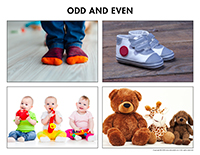
Poni discovers and presents-Odd and even numbers
(Open Poni discovers and presents-Odd and even) Print, laminate, and cut the cards. Use your Poni puppet or another puppet that children are familiar with to present the pictures to your group.
Let’s chat
(Open word flashcards-Odd and even) Print and laminate the word flashcards. Have each child pick a flashcard and take turns presenting the item to the group. Discuss each item to see what children know about the theme.
AREA SETUP
Thematic poster-Odd and even
(Open thematic poster-Odd and even) Print and display within your daycare.
Educa-theme-Odd and even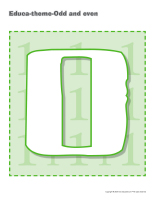
(Open educa-theme-Odd and even) Print and laminate the different elements representing the theme. Use them to present the theme to your group (and parents) while decorating your daycare.
Educa-decorate-Odd and even
(Open educa-decorate-Odd and even) Print, laminate, and cut out the illustrations. Use them to decorate your walls and set the mood for the theme.
Stickers-Odd and even
(Open stickers-Odd and even) Print the illustrations on adhesive paper and use them to create unique stickers.
Odd and even ceiling
Create a mobile by hanging sets of different shapes and items or simply numbers from the ceiling, over your changing table. You will find illustrations you can use in the Educatall club.
Integrating odd and even numbers throughout your daycare
Here are a few ideas:
- Provide number-shaped cookie cutters. Use them to trace and cut out numbers that you can display on walls, floors, the ceiling, under tables, in your various workshops, on toys, etc.
- Provide number stickers.
- Cut numbers out of colorful paper and glue them on paper plates. Hang them on a string to form a banner.
PICTURE GAME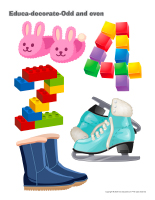
The pictures may be used as a memory game or to spark a conversation with the group. Use them to decorate the daycare or a specific thematic corner. (Open picture game-Odd and even) Print, laminate, and store in a “Ziploc” bag or in your thematic bins.
Memory game-Odd and even
(Open picture game-Odd and even) Print the pictures twice and use them for a memory game.
ACTIVITY AND WRITING SHEETS
Activity sheets are provided for each theme. Print and follow instructions. (Open activity sheets-Odd and even)
Educa-nuudles-Odd and even
(Open educa-nuudles-Odd and even) Print for each child. Have children color the sheet and use Magic Nuudles to give it a three-dimensional look.
Variation: You don’t have Magic Nuudles? Have children fill the spaces designed for Magic Nuudles with bingo markers or stickers.
To order Magic Nuudles:
http://www.educatout.com/catalog/index.php?cPath=76&osCsid=dfe8ad15c191a07bc61cf20f10cf6ca0
LANGUAGE ACTIVITIES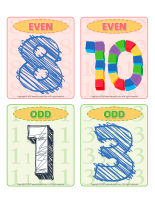
The flashcards may be used during circle time to spark a conversation with the group or in your reading and writing area. They may also be used to identify your thematic bins. (Open word flashcards-Odd and even) (Open giant word flashcards-Odd and even) 0/zero, 2/two, 4/four, 6/six, 8/eight, 10/ten, 1/one, 3/three, 5/five, 7/seven, 9/nine, 11/eleven
Story and memory game-Odd and even
(Open story and memory game-Odd and even) Print, cut out, and laminate the pictures. Place the cards face down on the floor. Children pick three cards and invent a story in relation to the illustrations. Variation: Print the pictures twice and use them as a memory game.
Odd and even scene
(Open scene-Odd and even) Print, laminate, and cut out the items. Children use the different pieces to decorate the scene as they wish.
ROUTINES AND TRANSITIONS
Game-This is my spot-Odd and even
(Open transition games-Odd and even) Print each illustration twice. Use adhesive paper to secure one copy of each illustration on the table. Deposit the second copy of each illustration in an opaque bag and invite children to pick a card that will determine their spot at the table (corresponding illustration). The illustrations can also be used to determine children’s naptime spots or their place in the task train.
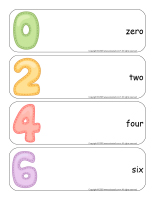
My odd and even path
(Open transition games-Odd and even) Print, laminate, and arrange the pictures on the floor to create a path leading to various areas within your daycare. The path can lead to areas frequently visited by children throughout the day such as the bathroom, the cloakroom, etc. or, if you prefer, delimit your workshops.
Odd and even numbers in our daily routine
Take advantage of routines to count the stairs as you go upstairs or downstairs, orange segments at snack time, children’s toes during diaper changes, etc.
PHYSICAL ACTIVITY AND MOTOR SKILLS
Hunting for even numbers
(Open even numbers) Print and laminate. Show children an even number and invite them to collect the corresponding number of objects.
Hunting for odd numbers
(Open odd numbers) Print and laminate. Show children an odd number and invite them to collect the corresponding number of objects.
Sock pairs
Collect several pairs of socks. Set one sock from each pair in a bag. Set the other socks on the floor, in front of your group. Have each child pick a sock out of your bag and search for the matching sock to complete the pair. The game continues until all the socks have been matched.
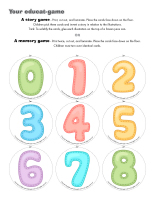
My twin
Set pairs of clothing items (mittens, socks, boots, shoes, etc.) in a bag. Divide your group into teams of two children. The first child from each team picks a certain number of clothing items (a single item from each pair) out of the bag and puts them on. His partner must find the matching items and put them on so that they look like twins.
Pairs of drawings
Print two copies of several different coloring pages. Divide your group into pairs. Have each pair pick a drawing. The first child colors the drawing as he wishes and his partner colors the second copy using the same colors. In the end, both drawings must be exactly the same.
Hanging pairs of socks
(Open hanging pairs of socks) Print two copies. Laminate and cut out the pieces. Hang one set of socks on a clothesline and drop the socks from the second set in a bag. Invite children to pick a sock, name its color, and hang it next to the matching sock, on the clothesline.
Pairs of sounds
Use opaque containers that are all the same size. Add an element to each container (rice, uncooked pasta, sand, water, etc.), making sure each element is added to 2 different containers that will produce the same sound when children shake them. Seal the containers and encourage children to shake them, challenging them to find containers that produce the same sound. When they think they have found matching sounds, have them set the containers next to each other. At the end of the activity, open the containers to verify their hypotheses.
Odd and even numbers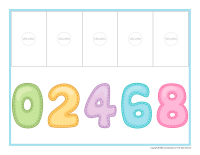
(Open game-Odd and even numbers) Print and laminate. Stick Velcro where needed. Arrange both number series in front of your group. Arrrange the number cards in a pile. Children take turns picking a number. Together, name the number and identify it in the odd or even number series. Press it in the right spot.
Touching pairs
Fill an opaque bag with pieces of fabric and objects that have a distinct texture. Spread a second set of fabric pieces and objects in front of your group. Select an item and encourage a child to touch it. Next, have the child plunge his hand in the bag and feel the items it contains in order to pull the corresponding item out of the bag.
Pairs of cards
For this activity, you will need a deck of playing cards. Divide the deck in half, keeping two 1s, two 2s, etc. Set the cards in the center of the table, face down. Children pick 4 cards to begin. The first player picks one of his cards and asks one of his peers if he has this card. If he does, he hands it to his friend who sets the pair of cards on the table in front of him. If the child does not have the requested card, the child who asked for it must pick a card form the center of the table. In the end, the child who has the most pairs wins. Here, do not worry about suits (hearts, spades, clubs, and diamonds), look only at the numbers on the cards.
Two-step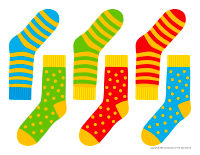
Create simple rhythmic games with your group by asking them to execute two types of movement at a time. For example, you may invite them to take 2 steps to the right, 2 steps backwards, to hop forward 2 times, etc.
Even number treasure hunt
Hide several objects in your yard (or daycare). Hide several number 2s also. Invite children to search for the items. They must collect 2 objects at a time, but they must also hand you a number 2 with each set of objects.
Odd number treasure hunt
Hide several objects in your yard (or daycare). Hide several number 3s also. Invite children to search for the items. They must collect 3 objects at a time, but they must also hand you a number 3 with each set of objects.
Odd or even pyramid
(Open stickers-Odd or even) Print and use the stickers to create games. Collect different sizes of empty metal cans. Decorate them with the stickers. Use the cans to build a pyramid and determine whether it is an odd or even pyramid (number of metal cans). Encourage children to try to make the pyramid fall with a frisbee. Give each child two tries if you have built an even pyramid and three tries if you’ve built an odd pyramid.
Odd and even construction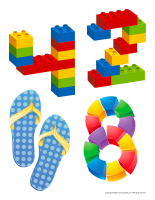
Give each child the same series of items (ex. 1 building block, 1 box, 1 toy car, 1 food item, etc.). Give verbal instructions that will help children explore spatial concepts. For example, you may invite children to set the toy car on the box, the food item to the right of the car, and the building block behind the box. Have children compare their constructions to see if they are identical and determine if their construction contains an odd or even number of items.
Twin shape series
(Open twin shape series) Print and laminate. Cut out the shapes and series. Give each child a series and encourage them to complete it using the smaller shapes.
Box of odd and even numbers
Use a box that has a lid. Cut round holes out of the sides of the box. Let children insert balls through the holes. Count the balls that they insert with them. Variation: Next to each hole, write a number (1, 2, or 3). Every time a child inserts a ball, name the number next to the hole.
Even cards, odd cards
Divide you group into pairs. For each pair, set one or several decks of playing cards on the floor, face up. The object of the game is to sort the cards (arrange all four 2s together, all four 5s together, etc.) as quickly as possible. The first team who sorts all their cards will be the winning team.
Odd or even pyramid
You will need twelve empty toilet paper rolls. With your group, stack them, counting them as you work: “1 roll, 2 rolls, 3 rolls, etc.” Keep going until the pyramid topples. Did you build an odd or even pyramid before it fell (number of rolls)?
Giant die-Odd or even
Use a cardboard box or large foam puzzle pieces assembled to form a cube to create a giant die. On each face of your die, glue a number and an object (ex. 4 trucks, 2 dolls, 5 building blocks, etc.). Children take turns rolling your giant die to determine which items they must collect. Encourage children to tell you if they rolled an odd or even number.
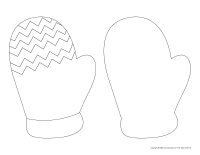
COGNITIVE ACTIVITIES
My pair of mittens
(Open my pair of mittens) Print. Invite children to observe the mitten that is drawn on the page and reproduce the designs on the blank mitten to create a matching pair.
Even designs
(Open even designs) Print and laminate. Set the design contours in front of your group. Have one child pick a card, observe it closely, and set it in the corresponding square.
Odd numbers-3D
(Open roll & color-3D-Odd and even) Print for each child. Assemble one die. This game can be enjoyed individually or as a group. Children take turns rolling the die, counting the dots, and coloring the corresponding part. The first child who finishes coloring the picture wins.
Counting cards-Odd and even
(Open counting cards-Odd and even) Print and laminate. Prepare a series of wooden clothespins on which you can paint or draw numbers 1 to 9. Children count the items on each card and place the corresponding clothespin on the correct number.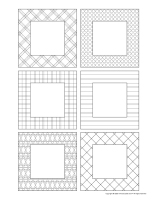
Educ-pairs-Odd and even
(Open educ-pairs-Odd and even) Print. Children must draw a line between identical items or color them using the same color. For durable, eco-friendly use, laminate and use dry-erase markers.
Educ-trace-Odd and even
(Open educ-trace-Odd and even) Print for each child. Children must trace each line using a crayon of the corresponding color and then color the object at the end of the line using the same color.
Educ-same and different-Odd and even
(Open educa-same and different-Odd and even) Print and laminate for durable, eco-friendly use. Children must circle the item that is different in each row.
Hunt and seek-Odd and even
(Open hunt and seek-Odd and even) Print and laminate. Children pick a card and search for the illustrated item in the scene.
Rice bin-Odd and even
(Open miniature odd and even numbers) Print and laminate for durable, eco-friendly use. Hide the tiny odd and even numbers, Fun Foam numbers, or magnetic numbers in a rice or pasta bin. Encourage children to search for them.
Twin shape series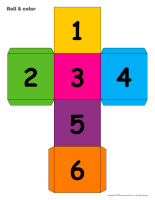
(Open twin shape series) Print and laminate. Cut out the shapes and series. Give each child a series and encourage them to complete it using the smaller shapes.
Number chart
(Open chart-Number) Print, laminate, and display at children’s level. Using Velcro, children press the correct number of symbols next to each number.
Numbered bottles
You will need 10 clear bottles. Number them from 0 to 9. Leave the bottle with “0” on it empty. Encourage children to drop 1 item in the bottle with number “1” printed on it, 2 items in the bottle with number “2” on it, and so on.
ARTS & CRAFTS
Puppets-Odd and even
(Open puppets-Odd and even) Print the puppet models on heavy paper. Have children cut them out and decorate them using various arts & crafts materials. Glue each one on a Popsicle stick.
Odd and even hat
(Open educa-decorate-Odd and even) Print and cut out the items. Glue them on a strip of construction paper or headband.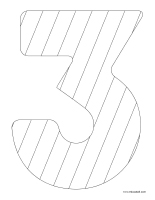
Crumpled paper numbers
(Open models-Numbers) Print a number for each child. Invite them to tear and crumple pieces of tissue paper that they can glue on their number. Encourage them to fill their number with colorful pieces of crumpled paper.
Opposite drawings
Have children draw on black paper using white crayons to create a drawing with “opposite” or contrasting colors.
Upside down
Set a white paper tablecloth on your table. Tape a large piece of white paper under your table too. You can, for example, encourage children to draw a daytime scene on the top of your table and a nighttime scene under your table.
COLORING PAGES
My coloring book-Odd numbers
(Open coloring pages theme-Odd numbers) Print for each child.
My coloring book-Even numbers
(Open coloring pages theme-Even numbers) Print for each child.
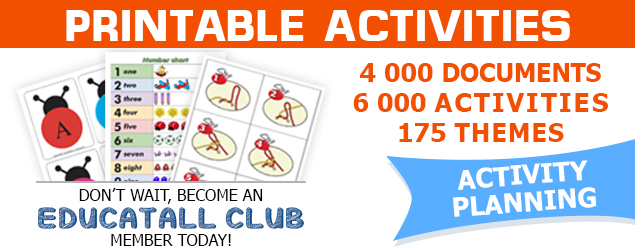
 Home
Home Theme activities
Theme activities
 Babies and toddlers
Babies and toddlers
 Arts and crafts
Arts and crafts
 Science
Science
 Creative recipes
Creative recipes
 Tips and tricks
Tips and tricks
 Special needs
Special needs
 Extra activities
Extra activities
 Educ-TV
Educ-TV
 Newsletter
Newsletter  Online store
Online store Educatall club
Educatall club

